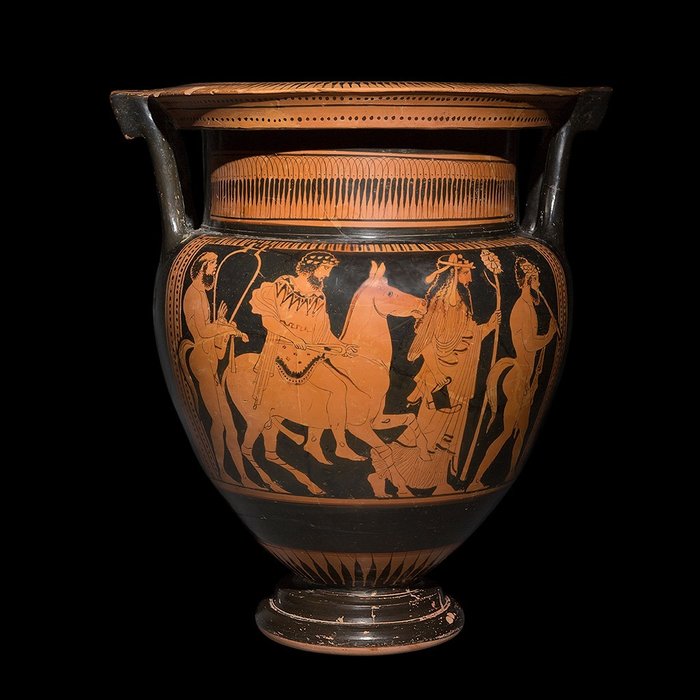
1 pcs 海蓝宝石 - 4.09 ct - * 没有储备 *
编号 41692183

编号 41692183

Krater of columns with the return of Hephaestus to Olympus accompanied by Dionysus
CULTURE: Greek, Attica
PERIOD: c. 425 - 430 BC
AUTHOR: Attributed to the Hephaistos Painter
MATERIAL: Pottery
DIMENSIONS: Height 49 cm; Diameter 38 cm
PROVENANCE: Private collection M. C., France. Acquired by offspring of the brother of his mother, collected between 1930 and 1960.
CONDITION: Reassembled from its original fragments without missing pieces or repainting.
DOCUMENTS: - With thermoluminescence test.
DESCRIPTION:
Athenian red-figure vase-painter whose name is unknown. Nevertheless consistent individual characteristics of style suggest the existence of a unique artistic personality. Beazley called him the Hephaistos Painter naming him after an image of the return of Hephaistos on a krater in Naples. He was one of the Later Mannerists and specialised in decorating large pots, mostly kraters. A large number of vases have been attributed to his hand on the basis of style.
The krater is a type of Greek pottery used to mix water and wine and from which cups were filled. It was moved to the space were a meal was to be eaten and was placed either on the ground or on a dais and the steward in charge of drawing the wine used a ladle to pour it into the guests’ cups. Kraters were mostly ceramic but some were made from precious metals, and were made in a variety of shapes according to the taste of the artist, although they did always have a wide mouth. The mostly widely occurring ones are column kraters, calyx kraters, bell kraters and volute ones.
Red-figure pottery was one of the most important figurative styles of Greek production. It developed in Greece around the year 530 BC and was used until the 3rd Century BC. It took the place of the previously dominant style of black-figure pottery within a few decades. The technical base was the same in both cases, but in the red-figure pieces the colour was reversed, so that the figures stood out against a dark background as if they were lit up by theatrical lighting, following a more natural scheme. The painters who worked with black figures were forced to keep motifs clearly separated one from the other and to limit the complexity of the illustration. In contrast, the red-figure technique allowed greater freedom. Each figure was silhouetted against a dark background allowing the painters to render anatomic details with greater exactitude and variety.
The technique consisted of painting motifs on a still moist piece, using a transparent glossy slip which, on firing, took on an intense black coloration. The motifs were therefore invisible before the firing and so painters had to work completely from memory without seeing the result of their work beforehand. Once the piece had been fired the zones not covered by the slip retained the reddish tone of the clay, while those that had been “painted” with the slip took on a dense, brilliant black coloration.
PARALELLS:
Hephaistos Painter:
- Krater of colums, Hephaistos Pinter. British Museum. England. Item number 1772,0320.36.
- Vase number 214729 published and catalog for J. D. Beazley.
Myth:
- Skyphos of the Kleophon Painter. Toledo Museum of Art. USA. Item number 1982.88.
BIBLIOGRAPHY:
- BOARDMAN, John. Athenian Red Figure Vases. Thames and Hudson World of Art. 2003.
The seller guarantees that he acquired this piece according to all national and international laws related to the ownership of cultural property. Provenance statement seen by Catawiki.
The seller will take care that any necessary permits, like an export license will be arranged, he will inform the buyer about the status of it if this takes more than a few days.
#exclusiveselection